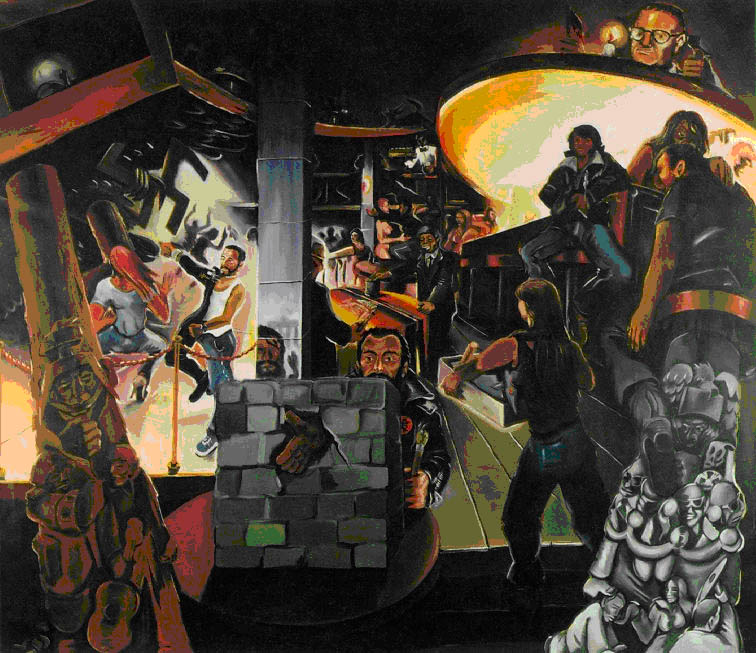
Reserved Area
Artists - ArtWorks
Jörg Immendorff
 Germany
GermanyJörg Immendorff “Café Deutschland“
Starting with neo-dadaistical tendencies like his `Lidl Campagne`he got involved in happenings that led to the exclusion of the Art Academy Düsseldorf in 1969. His political tendencies got more and more important to the content of his paintings as well as his historical way of painting. He kept close to politics trying to keep in touch with German politicians like Gerhard Schröder, for whom he painted a large portrait that is now part of the German chancellery.
Immendorff also created sculptures that often show apes, the historical symbol for the artist in which he tried to express the humanity of this creature.
In his later work graphics started to play an important role: He made a lot of screenprints to give poorer people the chance to get one of his artworks.
Immendorff began his famous series of Café Deutschland in 1977 and finished it 6 years later. In this artwork he already predicted the reunification of Eastern and Western Germany.
In the 1960ies he studied at the Art-Academy of Düsseldorf in Joseph Beuys`class.After some neo-dadaistic actions he was thrown out of this establishment. He decided to work as an art teacher for 12 years, and after that he got back into fine arts. In 1972 he participated at the documenta in Kassel, five years later at the Biennal of Venice.
His expressive way of painting was influenced by Markus Lüpertz and Georg Baselitz. Already in the 60ies they decided to get back to an “Abstract Expressionism” that is independent and not bound to a certain style.
In addition, the artist`s historical references were influenced by Anselm Kiefer, whose paintings deal with the history of our country.
The visual rooms depicted in his Café Deutschland series (16 large paintings!) were taken from the discotheque `Ratinger Hof`in Düsseldorf. Main characters for these depictions were those involved in the conflict between east and west.The series is painted in a colourful manner; they are expressions of a man who tried to catch the political importance of the conflict between the two parts of Germany painted in n expressional way.
The conceptual building blocks of this series is referring to Renato Guttuso`s “Café Greco” that was exhibited in Cologne in 1977. After seing this picture, Immendirff started to produce numerous gouaches and sketches that led to the structure of the works scenery.
Besides, his way of painting shows mutual influences of the Abstract Expressionism of painters like de Kooning or Francis Bacon.
After ”Café Deutschland” he produced other series of like Café de Flore in which he let loose of political articulation but searching for references to modern art. He also started to work on sculptures, e.g. the “Naht” scupture for the documenta in 1982 and his apes that show the “enemy of a painter”,as he stated himself.
None of the artists could be named “most important artist” as there are some important personalities for each country and century. Some find Gerhard Richter is important as he is internationally acknowleged, some say Expressionsts like Ernst Ludwig Kirchner are important. At last we decided to choose Immendorff as it is a great example for the students to get to know about the reunification, a part of our history and an easy access via the visual depictions of “Café Deutschland”.
„Immendorff besucht y. Deutschland mal Deutschland - Ein Deutsch-Deutscher Vertrag“ (1979), „Interview mit Joseph Beuys, Fortsetzung“ (1979), „Brandenburger Tor – Weltfrage“ (1982), „FF-bringts“ (1983), 1984 „FF-bringts 'La Paloma'“ (1984), „Ein Gedicht“ (1986), „Monolog im Malerhauptquartier“ (1987) „Dem alten Wahnsinn entgegen“ (1989), Wenn das Bild zum Berg kommt (2005),
Werkverzeichnis Jörg Immendorff (2006), Sculptures 1986-2005“(2007)
http://www.avantgart.com/Bio-Immendorff.htm
http://de.wikipedia.org/wiki/J%C3%B6rg_Immendorff
http://www.spiegel.de/kultur/gesellschaft/0,1518,485294,00.html
Related Material:
Image available

File name: 93_xx Café Deutschland.jpg
Description of the material:
Café Deutschland 1 (oil on canvas)
Contextualisation Of the source:
The painting is located at the Museum Ludwig in Cologne Dimensions 280 x 320 cm See: www.artchive.com
Interpretation of the source:
The painting represents the reunification of East and West Germany.
Comments about this Artist/ArtWork
Date: 2009.04.22
Posted by emma ciceri
Message: Goodmorning,
I asked myself as they have been selected the artists representatives of the several centuries and countries.
For XX the century me it would seem interesting to propose an artist like Joseph Beuys. Tension between life and art creed can entusiasmare and get passionate the boys.
Michelangelo - Copyright 2008 - This project has been funded with support from the European Commission